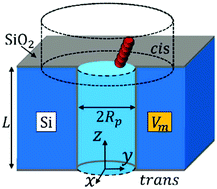Brownian dynamics of cylindrical capsule-like particles in a nanopore in an electrically biased solid-state membrane
Abstract
We use Brownian dynamics simulations to study the motion of cylindrical capsule-like particles (capsules) as they translocate through nanopores of various radii in an electrically biased silicon membrane. We find that for all pore sizes the electrostatic interaction between the particle and the pore results in the particle localization towards the pore 's center when the membrane and the particle have charges of the same sign (case 1) while in case of the opposite sign charges, the capsule prefers to stay near and along the nanopore wall (case 2). The preferential localization leads to all capsules rotating less while inside the pore compared to the bulk solution, with a larger net charge and/or particle length resulting in a smaller range of rotational movement. It also strongly affects the whole translocation process: in the first case, the translocation is due to the free diffusion along the pore axis and is weakly dependent on the particle charge and the nanopore radius while in the second case, the translocation time dramatically increases with the particle size and charge as the capsule gets “stuck” to the nanopore surface.

- This article is part of the themed collection: New Perspectives on Molecular Simulation of Chemistry and Physics in External Electric Fields


 Please wait while we load your content...
Please wait while we load your content...
